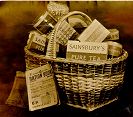|
Goods Rationed |
|||||||||||
The system was extremely complex as products were rationed at different times and in different ways. Butter, bacon and sugar were the first goods to be rationed in January 1940. They were followed by meat and preserves in March 1940, tea, margarine and cooking fats in July 1940 and cheese in 1941. Sugar, bacon, butter, cheese and cooking fats were rationed by weight and the relevant coupons entitled the customer to buy a given weight. Jam and other preserves were rationed as a group so that customers could choose whether to buy jam, marmalade or syrup. At some points in the war they could 'swap' the jam ration for extra sugar.
To complicate matters further an individual's entitlement varied according to the food supply and their occupation. The distribution of a number of important foods such as milk, eggs and oranges was controlled to ensure that special allowances could be made for expectant mothers, babies and the elderly. Sainsbury's prewar style of trading placed it at a disadvantage in obtaining registration because most of its prewar business had been the sale of meat and provisions such as bacon and dairy produce. As these were rationed, the company was particularly vulnerable if customers transferred their registrations to other retailers.
Customers were also lost because Sainsbury's trading heartland in London and the South-east was the area most affected by evacuation. Many regular customers left their homes for long periods in the war. A third factor was that the high street sites, which had been so profitable in the interwar years, became less attractive to customers faced with air raids, a disrupted public transport system and the blackout. For many people it was more convenient to register at their local corner shop.
|


